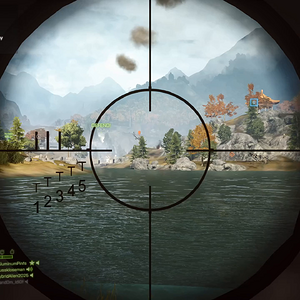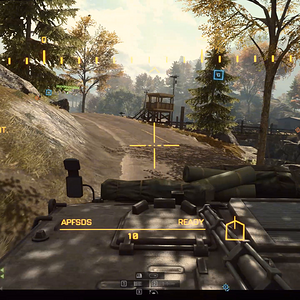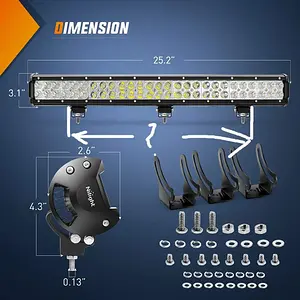Desktop condenser mics, if you think about it, have to do quite a difficult job. From a reasonable distance, a microphone is expected to sit on your desk—likely near to a PC with fan noise and other interference-emitting devices—and pick up a good vocal signal, while hopefully rejecting as much unwanted noise as is reasonable. And, let's face it, it'd be nice if it looked good while it was doing it, too.
The Razer Seiren V3 Chroma has the last part down at the very least. Pulling it from its packaging reveals a handsome, pill-shaped device with a screw-in base and a matte finish that looks suitably professional. It's tiltable on its stand thanks to two nicely knurled side mounted knobs, and features just the one solitary dial at first glance.
Oi, who's gone and nicked all me controls then, you may well think, or at least I did as a previous near-London resident.
A closer inspection reveals that at the very top of the device is a hidden touch control for muting and other functions. Besides that, there's just a small USB Type-C connector around the back and a 3.5mm jack for headphone output. Minimalist, this little mic, although it feels and looks rather good doing it.
Seiren V3 Chroma specs
(Image credit: Andy Edser)
Polar patterns: Supercardioid
Connectivity: USB
Recording Sample Rate: 24-bit 96kHz
Frequency response: 20–20,000Hz
Features: Built-in Chroma RGB lighting, front dial, rear USB Type-C connectivity, 3.5mm headphone output
Price: $130/
£130
All that minimalism, however, goes away the second you plug it in. The Seiren V3 treats you to a frankly blazing display of colours on first connection, all emitted from underneath the holes of its substantial grille.
This is likely going to be a love it or hate it affair from the off, but personally as a fan of a bit of RGB illumination I did enjoy the effect, although at default settings it is surprisingly bright. Time to install the Razer Synapse software then, and get to grips with the options.
After a bit of update wrangling (and a required reboot, I might add) to get Synapse to behave itself and log me in reliably—and this isn't my first rodeo, messing around with Synapse and its tendency to be fiddly—you are eventually greeted with a mic menu screen that at first glance is blissfully easy to use.
There are sliders for microphone and headphone gain, dropdown menus to choose between two different functions for the front dial (microphone volume and headphone volume, if you were wondering) and options to configure that aforementioned top-mounted touch control.
Here you can configure the extra tap functions. One tap on the top mutes the mic and turns it an attractive shade of red, which should make it blissfully easy to tell if you've accidentally cut the audio on the mic itself on your next remote meeting. Two or three taps can be configured in a variety of ways, including cycling the Chroma RGB effects, turning them off entirely, or even using them as an audio meter.
I tried the latter, but disabled it very quickly. The RGB flashes on and off when it picks up a suitably loud signal, including the clacking of a mechanical keyboard, which means while writing this review I was subject to a series of eye-searing flashes with the setting on. A gradual flow of lighting from subtle green to stronger tones to indicate signal strength would be much easier on the eyes, but alas, I couldn't find an option for it
Image 1 of 6
(Image credit: Andy Edser)
Image 2 of 6
(Image credit: Andy Edser)
Image 3 of 6
(Image credit: Andy Edser)
Image 4 of 6
(Image credit: Andy Edser)
Image 5 of 6
(Image credit: Andy Edser)
Image 6 of 6
(Image credit: Andy Edser)
If you find the RGB LEDs in general to be on the strong side, flipping over to the lighting menu gives your a plethora of other options, including a much-needed slider to turn it down to something more reasonable, or even off entirely. Here I configured the Seiren V3 to deliver some pleasing, ever changing glows that would likely look good on your next stream cam. Ahhh. Much more soothing.
Anyway, enough about the pretty lights. Time for some audio tests, and for this I booted up Audacity, set the gain to something reasonable, and recorded some audio test clips you can find below:
You may notice that there's some background noise, including a distinct buzz with a little hiss, on a relatively low gain setting of 30 out of 100. I find it particularly obvious in 'dead air' sections like the two to three seconds at the end of the clip. I tried it in different USB ports and at different distances to try and figure out where it might be coming from on my otherwise quiet setup, but with no joy. I've recorded a fair few microphones from this system and in this room with no such issues, but it seems the Seiren V3 Chroma likes to add a bit of unwanted (and as best as I can tell, non-existent) background noise.
Searching around the settings for a software solution, again I thought I might be missing something. There's a high pass filter, which I had engaged, a digital gain limiter and auto gain control, but no actual noise suppression, reduction or noise gate option.
Not only that, but there's no adjustable EQ either. Luckily enough, as you can hear in the test clips, the little Razer does deliver a fairly warm, round rendition of your vocals on default settings, which is reasonably pleasant. It'd be nice to be able to tweak it, but in all honesty the depth of sound is pretty decent by default, so a mark in its favour there.
(Image credit: Razer)
However, it did have a little bit of a low input at even a relatively close range, even when pushing my dull baritone up to volumes that I would consider slightly obnoxious. Of course, you can turn up the gain to compensate, but without a proper noise suppressor this only makes the background noise worse, so I ended up putting the mic closer to me than I normally would to minimise it.
Of course, the closer you have a microphone to you, the better it's able to pick up your vocals, but given the need to boost the gain here and the lack of ability to properly tame unwanted noise, I found this limited where I could place the mic on my desk in order to get acceptable audio.
You could mount it on a boom arm to get it away from unwanted audio sources and nearer to your mouth for lower gain usage, and facility is provided for that via the socket that screws into the bottom of the base. However, for its primary purpose of sitting on your desk in its mount, looking pretty and capturing good audio, the Razer likes to get up close and personal to properly perform.
Where the software does shine, however, is the Stream Mixer settings. Here you can configure your inputs and outputs and your playback mix very easily thanks to some straightforward drop down menus, complete with an option to open Windows very own audio settings from within the app. That's a nice touch, and other audio software suites would do well to emulate it.
(Image credit: Razer)
While the Razer Seiren V3 Chroma is a very pretty thing, and is definitely capable of picking up a useable audio signal, its tendency to rely on higher gain settings in combination with a lack of software to tame them means it's a bit of a wild horse without the appropriate reins.
Buy if...
 If you love the RGB look:
If you love the RGB look: The Seiren V3 Chroma lights up in all sorts of interesting ways, and if you like a microphone that looks the part on stream, it's bound to have a setting for you.
 If you're looking for a warm sound:
If you're looking for a warm sound: While the Razer didn't excel in our audio tests, the sound profile is fairly warm, and has a good EQ balance at default for most users.
Don't buy if...
 If you want a totally clean signal:
If you want a totally clean signal: While the Seiren V3 isn't the noisiest mic I've ever heard, it did introduce an audible buzz and hiss even at low-ish gain settings, and you can't get rid of it without third-party apps.
 If you're on a budget:
If you're on a budget: At $130/£130, it's pretty pricey for what is essentially a slightly noisy condenser mic with some pretty lights.
You could, of course, make use of a third-party plugin for noise suppression duties, but given that this mic is marketed on the box as a plug and play audio device "for fuss-free setup" and comes in at a substantial price, you'd hope that it would come with a workable solution already built-in, and well, it doesn't.
That being said, it's not the only mic in a similar price range that's a little bit lacking on the software noise-reduction features, including the similarly light-up
HyperX Quadcast S that currently takes the "best looking" spot on our list of
the best microphones for gaming.
However, the HyperX also comes with a fancy elasticated shockmount and a range of directional patterns to pick from, and while the Razer professes to have a built-in shock absorber I still found it prone to picking up desk taps and clunks relatively easily, especially as I had to place it close to my keyboard to minimise the background noise.
If you don't mind skipping the RGB lighting, you could also pick up an
Audio-Technica AT2020USB+ for around half the money. It skimps out on audio software entirely, but it also provides a lovely rounded-yet-crisp sound, and if that's all you're after and you don't mind adding some third-party solutions of your own then it's difficult to see why you'd go for the Razer instead, unless you really are sold on the smaller form factor and the very shiny lights.
It likes being the centre of attention, this little mic, but while the Stream Mixer settings are great and the aesthetics are pleasing, it really could do with some decent noise reduction to help clean up its act.
Continue reading...















































